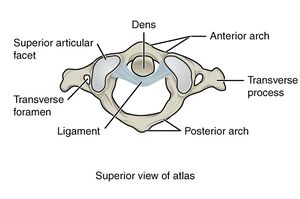Atlanto-occipital Joint
The atlas (C1) isn't really a true cervical vertebra both anatomically or functionally. It is more akin to an occipital vertebra as it resembles the occipital bone more than a cervical vertebra. Functionally it is also more closely linked to movement with the head than with the cervical spine.
Structure
The atlas has two lateral masses which is the most important bony structural feature.
Superiorly they present superior articular processes and articulate with the occipital condyles, called the atlanto-occipital joint. These are synovial joints and are the only direct connection between the skull and the atlas (C1).
Inferiorly the lateral masses have inferior articular processes that articulate with the axis (C2), forming the atlanto-axial joint.
Through the atlanto-axial joint the load from the head is transmitted to the rest of the cervical spine.
The atlas also has anterior and posterior arches. The primary purpose of these is to hold the two lateral masses in place.
Function
The atlanto-occipital joint provides a small amount of flexion and extension. Axial rotation is not possible due to the depth of their sockets. With axial rotation of the cervical spine, the atlas behaves passively sitting between the skull and the axis (C2)
Innervation
The C1 spinal nerve is unique. It does not have a typical dorsal root ganglion. The ganglion cells are located in the rootlets of the spinal accessory nerve. The dorsal ramus of C1 is found with the posterior suboccipital muscles. In some individuals there is a cutaneous branch. The ventral ramus of C1 runs past the posterior arch of the atlas (C1), behind the superior articular process.
C1 innervates the atlanto-occipital joint. It then enters the cervical plexus.


